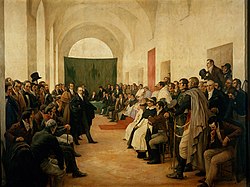Cabildo (council)


A cabildo (Spanish pronunciation: [kaˈβildo]) or ayuntamiento (Spanish: [aʝuntaˈmjento]) was a Spanish colonial and early postcolonial administrative council that governed a municipality. Cabildos were sometimes appointed, sometimes elected, but were considered to be representative of all land-owning heads of household (vecinos). The colonial cabildo was essentially the same as the one that was developed in medieval Castile.
The cabildo was the legal representative of the municipality and its vecinos before the
The word cabildo has the same Latin root (capitulum) as the English word
History

The Castilian cabildo has some similarities to the ancient Roman
The cabildo proper began its slow evolution in the process of the Reconquista. As fortified areas grew into urban centres, or older cities were incorporated into the expanding Christian kingdoms of Portugal, León and Castile, kings and sometimes local lords granted the cities various levels of self-rule and unique sets of laws (the fueros) and made them the administrative centre of a large terminus or alfoz, which was analogous to the ancient territorium. In general, municipal governments often consisted of a council (consejo) that was open to all the property-owning adult males of the city and a nobleman appointed to represent the king and organize the defense of the city and terminus. By the 13th century, these open councils proved unwieldy and were replaced by a smaller body, the cabildo or ayuntamiento consisting of set number of regidores (usually 24 in the largest cities) elected by the property owners in the city. The new bodies took their permanent form by the end of the 14th century. As part of the same process, a municipal council (the consell) with different attributes and composition also evolved in the neighboring Kingdom of Aragon during this period.[2]
Structure

In theory, every municipality in the Spanish colonies in the

The cabildo consisted of several types of officials. There were four to twelve regidores, depending on the size and importance of the municipality. Regidores were not just deliberative officers, but all shared in the administration of the territory by dividing tasks among themselves. Initially the regidores were elected by all the heads of household. In the late Middle Ages, those elections often turned violent, with citizens forming bands to control elections and even resorting to murder. To minimize that problem, kings began to appoint a certain number of or even all of the regidores in certain cities. By the modern era, different cabildos had different mixes of elected and appointed regidores both in Europe and overseas. Finally, to add another layer of control, the kings introduced corregidores to represent them directly and preside over the cabildos. Although many municipalities lost their right to elect all or some of their regidores as time went on, cities and cabildos gained new power with the development of the Castilian and Leonese Parliaments (the cortes) because cities had a right to representation in them.[3]
In addition to the council members, the cabildo had one or two magistrates, the
After the
Currently existing
Because cabildos were the city government, the city administrative offices were often called the "cabildo". Those names are preserved in parts of Latin America and even in New Orleans.
At present, cabildos exist only on the Canary Islands (cabildos insulares),with one governing each island, and they are elected. Cabildos there resemble the consells insulars (island councils) of the Balearic Islands.
See also

- Ayuntamiento
- Corregidor
- Municipal council
- The Cabildo
- Crown of Castile
- Open cabildo
- Alcalde
- Alcalde ordinario
- Sargento mayor
- Regidor
- Síndico
- Corregimiento
- Teniente a guerra
- Santa Hermandad
References
Sources
- Din, Gilbert C. (1996) The New Orleans Cabildo: Colonial Louisiana's First City Government, 1769-1803 Louisiana State University Press, Baton Rouge, ISBN 0-8071-2042-1
- Fisher, John (1969) "The Intendant System and the Cabildos of Peru, 1784-1810" The Hispanic American Historical Review 49(3): pp. 430–453
- "Municipios", Diccionario de Historia de Venezuela. Caracas: Fundación Polar, 1997. ISBN 980-6397-37-1
- O'Callaghan, Joseph F. A History of Medieval Spain. Ithaca, Cornell University Press, 1975. ISBN 0-8014-0880-6
- Pike, Fredrick B. (1960) "The Cabildo and Colonial Loyalty to Hapsburg Rulers" Journal of Inter-American Studies 2(4): pp. 405–420
- Pike, Fredrick B. (1958) "The Municipality and the System of Checks and Balances in Spanish American Colonial Administration" The Americas 15(2): pp. 139–158
- Meissner, Jochen (1993) Eine Elite im Umbruch: Der Stadtrat von Mexiko zwischen kolonialer Ordnung und unabhangigem Staat, 1761-1821 F. Steiner, Stuttgart, ISBN 3-515-06098-7, in German, (An Elite in the Breach: The Cabildos of Mexico between Colonial Order and the Unforgiving State)
